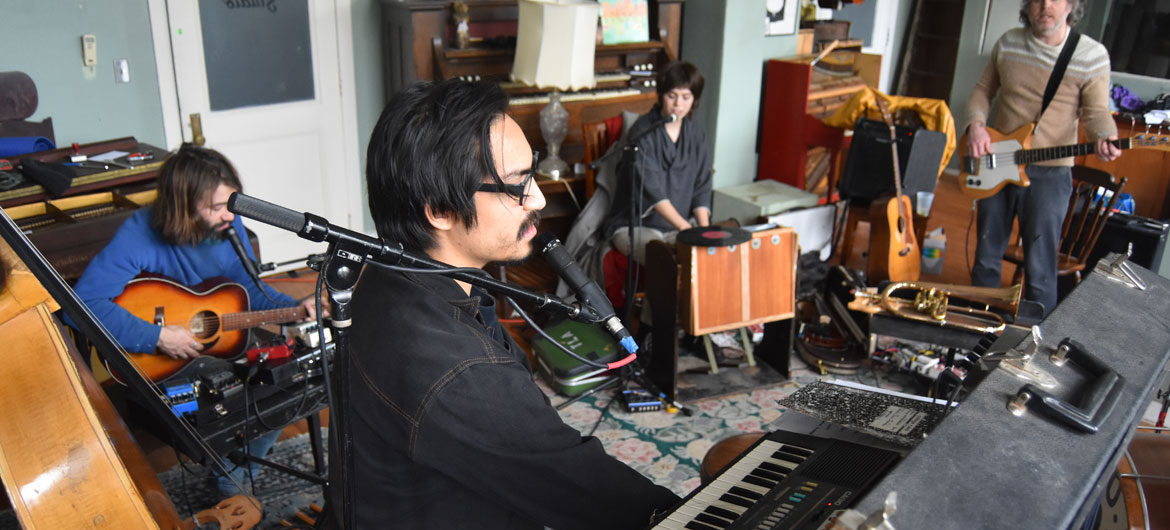Up past the golden lobby of Providence’s Columbus Theatre, still decorated with vintage posters advertising Verdi’s “La Traviata” and screenings of “The Song of the Soul” and Cecil B. DeMille’s “Il Massacro dei Cristiani,” past the doors to the ornate 800-seat hall with its grand murals and soaring proscenium arches, upstairs past the intimate 200-seat concert stage on the mezzanine, past the recording studio booth with its vast mixing board, past the boy getting his first drum lesson, is a large disheveled room arrayed with keyboards and guitars, drums and so many pedals.
The afternoon sun streams in the large windows overlooking Broadway as four members of the Providence band The Low Anthem—Ben Knox (he sometimes also adds the last name Miller), Jeff Prystowsky, Florence Wallis and Bryan Minto—launch into a rehearsal. A taxidermied deer head watches from a wall above.
“Dust was only flakes of skin / bone of sailor, bone of bird / sand was only skeleton / bone of sailor, bone of bird,” Knox sings and plays keyboard, accompanied by Prystowsky and Minto on guitar and Wallis on violin. They switch off on instruments. Prystowsky heads to his “mysterious station of sound” (“tubes and crystals,” Knox jokes) and then the keyboard. Wallis plays toy piano. Knox sits at the drums.
The Low Anthem’s new album “The Salt Doll Went To Measure The Depth Of The Sea,” which debuts today, is inspired by a Hindu mystic’s classic fable about the impossibility of trying to put into words what it’s like to embrace the universe’s ultimate reality. The music is filled with mentions of bones and seas, whales and krill, wrecks and sunken empires. They’re songs about transformation—skin to dust, sand to glass—and persistence during nature’s cosmic cycles. Knox sings on “Toowee Toowee”: “The sea we were cut from / the sea we will become.”
“There’s this element of the journey, the epic journey, the explorer,” Wallis says. “I think the effect of trying to find out the truth of anything is an exploration.”
The music pops and crackles like an old record and warbles like it’s underwater. Something like lonely carnival calliopes or music boxes twinkle and evaporate. The sound is blissful, luminous, dreamy, effervescent, hypnotic.
Tomorrow with a sold-out album release concert on the Columbus Theatre’s 200-seat stage, the Low Anthem will launch a tour that will bring them to the Iron Horse in North Hampton on March 2, Space Gallery in Portland on March 3, ArtsRiot in Burlington, Vermont, on March 4, then to Philadelphia and New York and D.C., a swing through the South and the Midwest, Chicago and Toronto, the UK and Europe, before a show at Boston’s Brighton Music Hall on May 22.
Help Wonderland keep producing our great coverage of local arts, cultures and activism by contributing to Wonderland on Patreon. And sign up for our free, weekly newsletter so that you don’t miss any of our reporting.
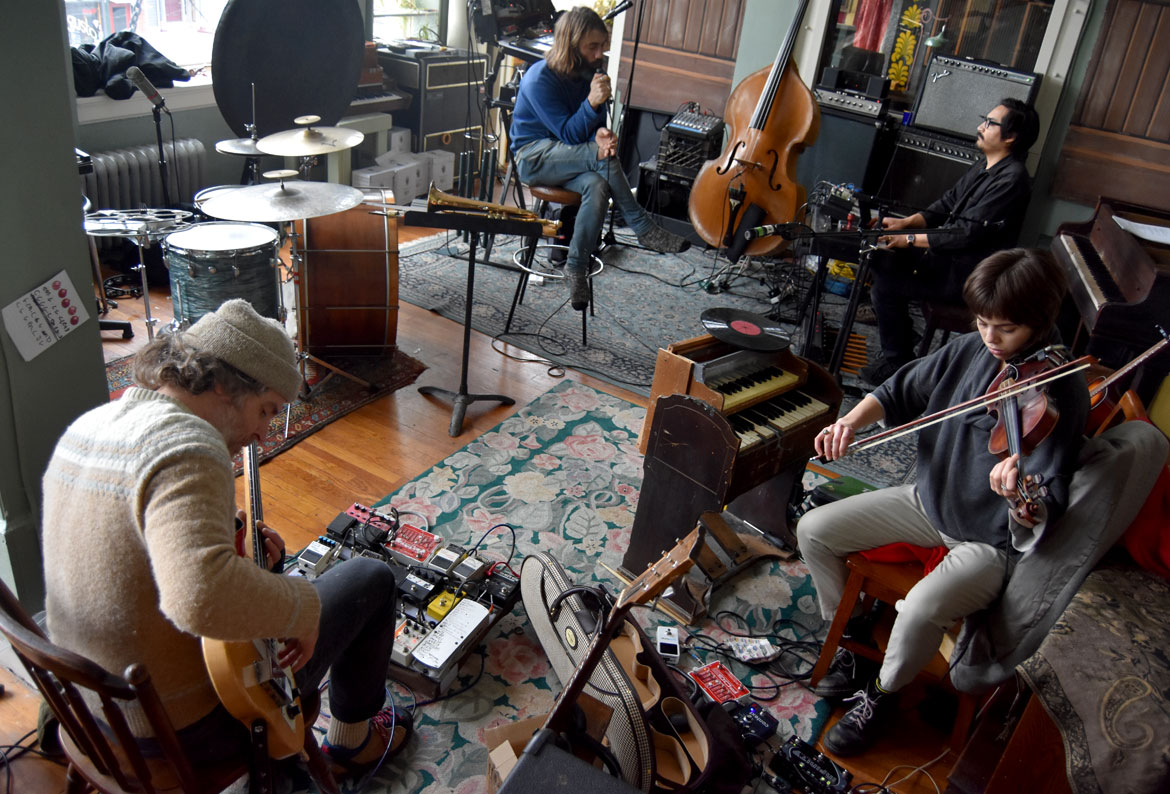
The band’s psychedelic-folk style, which they debuted on their 2016 album “Eyeland,” is a departure from the heart-achingly beautiful folk-pop songs and rumbling honky-tonk tunes that swiftly brought the band attention following the release of their 2007 debut album “What the Crow Brings” and their 2008 follow-up “Oh My God, Charlie Darwin.”
A Low Anthem lineup featuring Knox, Prystowsky and Jocie Adams played the Newport Folk Festival in 2009 (listen). (A number of additional folks have been in and out of the band over the years.) The group appeared on the “Late Show with David Letterman” a number of times beginning in 2010. They toured with Emmylou Harris and Iron & Wine and The Chieftains. They opened for Bruce Springsteen at South by Southwest in March 2012 and joined him on stage there for a giant hootenanny version of Woody Guthrie’s “This Land Is Your Land.”
“We know the ‘Darwin / Smart Flesh’ material inside and out,” the band announced to their mailing list that September. “Maybe some artists reach this point and become safer more refined imitations of themselves. We’re not interested. So…we’ve decided that this upcoming tour will be the last tour of the chapter. The last tour devoted to this material, this incarnation. … It’s not the end. There is no end. But it’s the last one for a while. We have too many unfulfilled ideas in the works to stay out on the road. … But it’s going to take some time back home, to turn the page and build a new sound world. To burn the furniture. To decipher the new questions.”
It took until June 2016 for “Eyeland” to arrive. Its long gestation fractured the band. “People split off because three years later there was no new record, no new gigs,” Knox tells me when I talk with the band in an Olneyville house that he’s renovating to live in. “So everyone moved on. Including our business management.”
When “Eyeland” finally came out, Knox and Prystowsky, who founded the band after meeting as students at Brown University, had been joined by Wallis and Minto. Knox recalls, “On day five of the tour, after waiting four and a half years to release it, on the first leg of the tour, we smashed the van.”
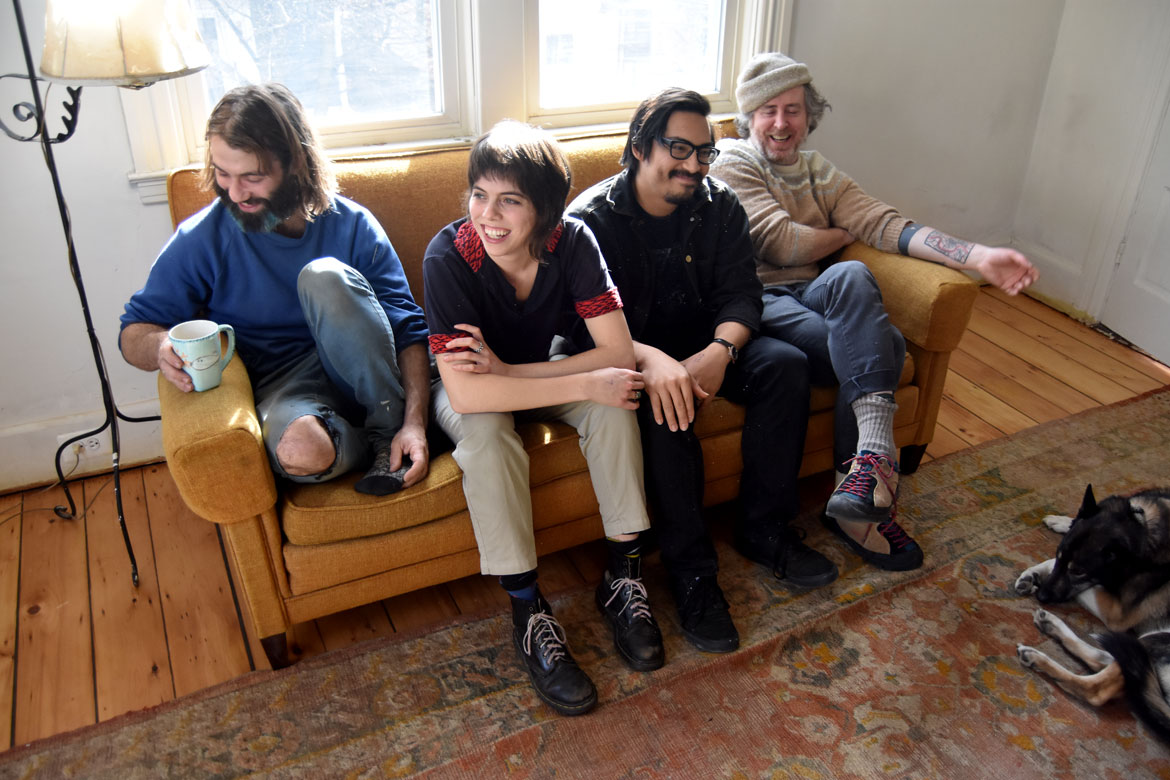
The Engine Was On Fire
“You’re gonna lose / You have to lose / You have to learn how to die / Just watching the miles flying by,” went the band Wilco’s song “War on War” on the radio.
Minto was singing along as he sat at the wheel of the forest green van around midday as the band—plus a videographer—motored down the highway to perform in Washington, D.C.

Prystowsky was in the front passenger seat: “I was dreaming and then it was a rude awakening. We got cut off on the highway, 60, 65 [miles an hour], we got cut off by someone going across two lanes to go into a rest area” at the center of the road.
Minto’s “fighter-pilot reactions saved the lives of a few pedestrians and yours truly,” the band said on Facebook on June 27, 2016. Instead of plowing into people pumping gas at the rest area or bouncing into a ditch, Prystowsky says, Minto drove head-on into a pole. “He actually split the pole in two so the pole went right between us.”
“When we had the first impact, there was this silence that seemed to spread out,” Minto says. “It was just hiss and smoke. And that song came blaring back on and I remember reaching back to turn the radio off.”
Knox, who was in the back, “just flipped in the air,” Wallis says. “And landed without a scratch,” Prystowsky adds.
“The engine was on fire. There’s blood everywhere. Who’s bleeding out?” Knox wondered. “I’m like someone’s got to be dying right now. … It turned out we had two cases of red wine and they had flown through the air and smashed.”
“It was really scary, but I saw this incredible sense of brotherhood between you two,” Minto says to Knox and Prystowsky.
“Normally it’s Jeff taking care of me because I’m really drunk,” Knox jokes.

Prystowsky was concussed, hurt his left leg and lost his sight—temporarily. Minto nearly broke an ankle and appeared in a photo the band posted to Facebook shortly after with a brace on his right leg and sporting crutches. Wallis “walked out with a scratched knee.” The videographer seems to have hurt her arm. Knox came through it basically unscathed. The band’s instruments were smashed to pieces.
Prystowsky, the worst injured, was “healing with his family in Jersey,” the band reported on Facebook. He recalls trying to cook eggs at one point and just dropping the whole carton of a dozen to the floor. “I broke down with them and was weeping in all the egg yolks.” He spent three weeks recovering. “With a concussion like that,” he says, “the doctor said no screens, no reading, no music. I couldn’t think. No inner thoughts.”
“That was the end of the album in the States really,” Knox says. “When that happened and the van was on fire that was like a Biblical sign that it was time to move on.”

This Weird Fractally Process
The creation of “Eyeland” already had been long and complicated—a period of experimentation. “It was about finding what gear could fit in my room and I could mess with it at 4 in the morning,” Knox recalls. They taught themselves how to record music while they were recording themselves for the album. Over the years it became “this weird fractally process that had different generations of shit from different periods of time.”
The process coincided with the band’s involvement in helping to renovate and manage Providence’s Columbus Theater so it could reopen for shows in November 2012. They set up their own recording studio on the second floor. (They continue to help book, promote and run shows there—as well as operating the studio and using the theater as their headquarters/practice space.)
“The theater for all intents and purposes had been closed for a decade,” Prystowsky tells me as he drives me to there in his Subaru station wagon. “It’s been there since 1926. In the basement we found all these old electronics from that era, found cabaret dancer feathers. … There’s something about the theater when you walk in there you lose a sense of what time and era you’re in. It’s timeless.”
This factored into the experimentation of “Eyeland” as well. “We moved into a theater,” Knox says, “and we had this huge space to blast sound around in.”
Now, after all the painstaking, laborious construction of the album, “The van was on fire,” Knox says. “I had lost all my protectiveness about this previous record.”
“That fire of the van, then turn the page,” Prystowsky says. “It’s two empty pages and make something else.”
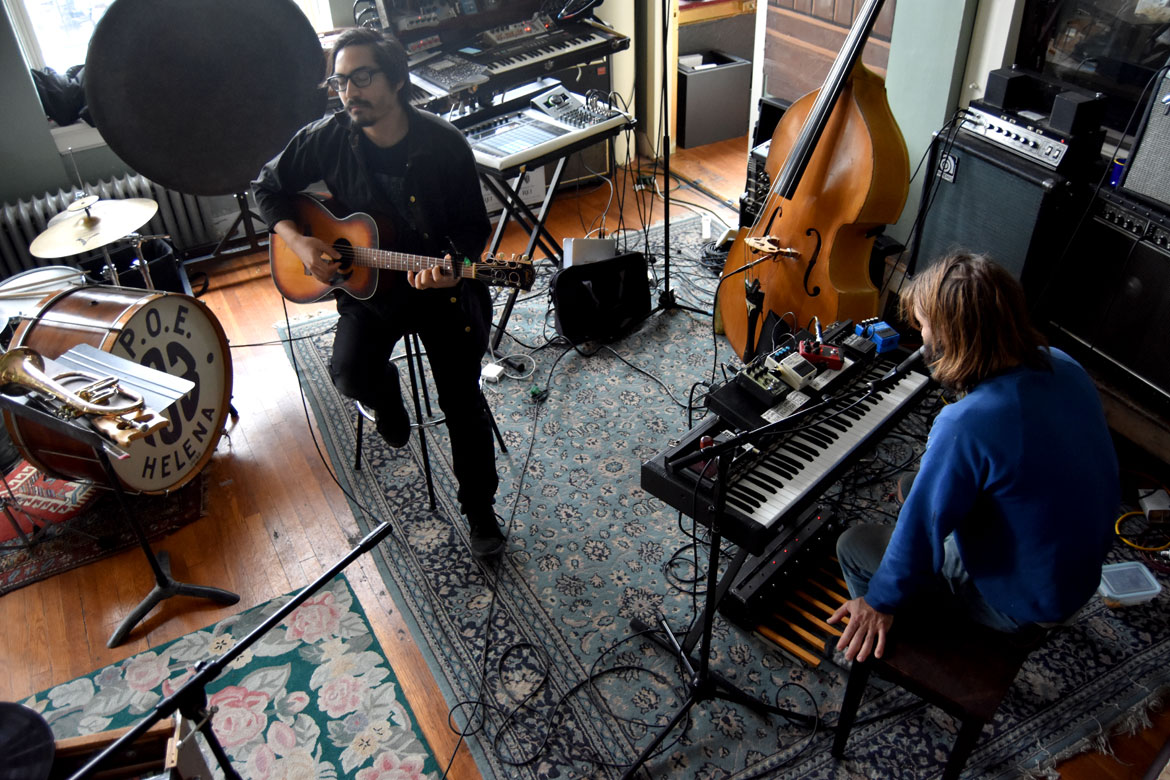
After The Noise Rushed Out
“I hadn’t written any songs in four and a half years since we started recording ‘Eyeland,’” Knox says. He’d not wanted to get distracted from finishing those songs by starting new ones. “It had been so long since I had looked at a blank page. When the noise of that rushed out and there was silence, any little thing, you could hear it again.”
After the crash, Knox and Minto rented a U-Haul truck, found the totaled van in a junkyard, loaded the wreckage of the band’s instruments into the rear, and drove back to Providence and the Columbus Theatre.
“I had left the room in a kind of Rube Goldberg status,” Knox recalls. Records and wind chimes and “one speaker was sending sounds out of a PVC pipe” and “I had a cat I was teaching to play piano. All this energy, all this sound was happening. All this sound was waiting for me. I didn’t have anything to do because the tour was cancelled. I never have nothing to do.”
So Knox burrowed into 16 days of songwriting: “I did one song every day.”
On his mind was Kay Larson’s 2012 book “Where the Heart Beats: John Cage, Zen Buddhism, and the Inner Life of Artists.”
“It was about [Cage’s] parallel pursuits of art and Buddhist philosophy and the way the two are influencing each other,” Knox says. The avant-garde composer’s pursuit of Buddhism inspired Cage to open his music to indeterminacy, chance and silence—as in his landmark 1952 composition 4’33” in which a musician sat at a piano for four minutes and 33 seconds playing nothing and your mind opened to the sounds of the room and then the universe. “This eccentric genius needing to communicate and the lengths he was going to,” Knox marvels.
About a third of the way through the book, Knox found a story about the 19th century Hindu mystic Ramakrishna.
“Ramakrishna gazes lovingly at this disciples. ‘Once a salt doll went to measure the depth of the ocean.’ Ramakrishna’s companions laugh; they know what comes next. ‘It wanted to tell others how deep the water was. But this it could never do, for no sooner had it got into the water than it melted. Now who was there to speak about the depth?’” Larson writes.
“The story exists to explain samadhi, the moment of bliss and oneness in Hindu practice,” Knox says. “To go fully in there is also to be unable to communicate about it.”
“The contradiction the little salt doll offered, that hit me pretty hard,” Knox says. The songs became a concept album about the salt doll, about cycles of life, about things changing states and then returning back again.
Cage’s style also percolated though the music. Knox says, “This record was looking for the very smallest sounds. It started with the sounds of scratches on records. It happened by accident.”
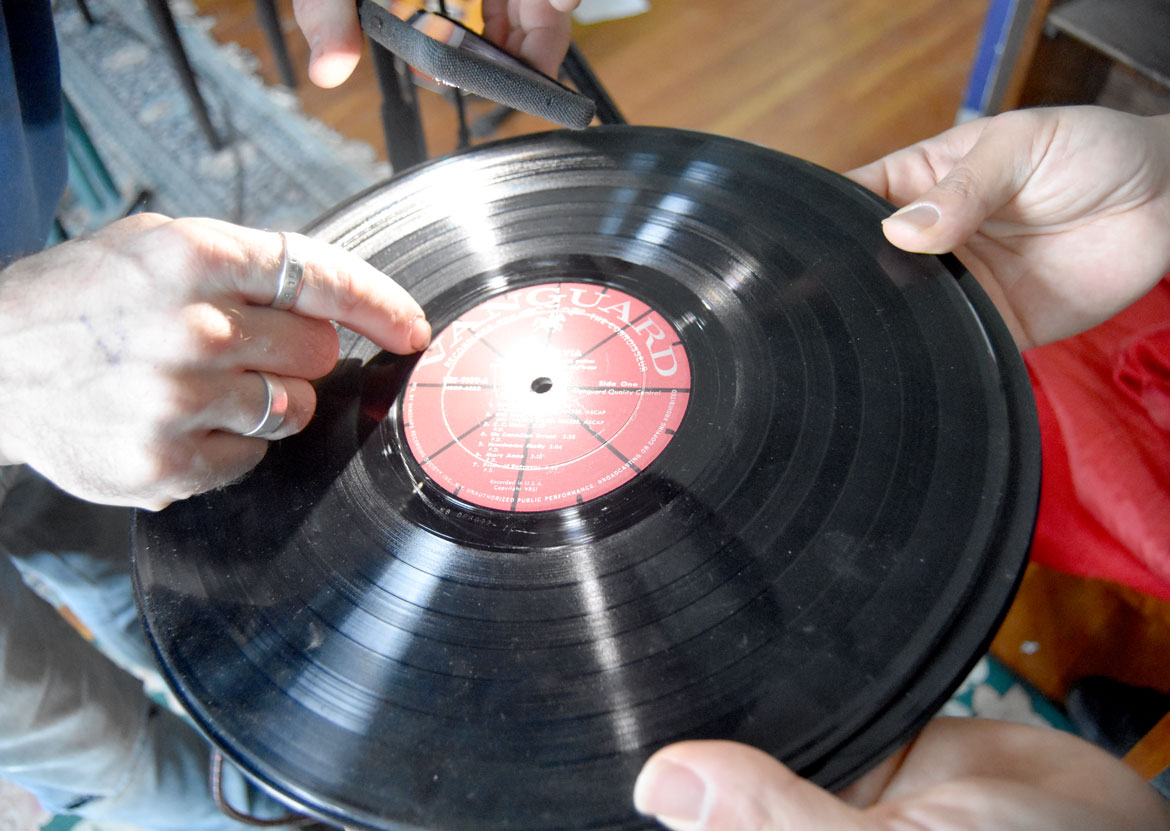
The pops and scratches in the songs are the actual sounds of a needle circling the gutters at the end of records, in the gap between the end of the music and the beginning of the label in the center.
“Maybe you’re stoned or daydreaming and you think I should get up and turn that off,” Knox says, “but two and a half hours later, you’re still listening.” He drew this out by doctoring the actual records. “On the label, I would use a pen to mark where the time lined up. … I would us a tiny awl to mark where the beats might go. There’s something about how that circle keeps time.”
Knox says, “It’s brought all the way up in the gain stage, brought up into our perception. It’s like looking at dust under the microscope.”
“That idea continued through the record,” Prystowsky says. “Chopsticks on the edge of a paper bag. All these little sounds where you can hear the edges and the beginnings of the sound.”
“Just barely touching it,” Knox says. “There were a lot of toy instruments and weird instruments because all of our instruments had been destroyed in the car crash.”
“Not as dense, not as layered as the last one,” Prystowsky says. “A lot more space.”
“Infinitely spinning vinyl records,” Prystowsky says, inspired meditations on cosmic cycles. “Circular ideas and physical circularity going on at the same time. … There’s a lot of songs on the album which describe cycles which return to where they’ve begun.”

A Reflective Moment
“Silica and soda ash / smelted into bottle glass,” Knox sings on the new album’s song “Bone of Sailor, Bone of Bird.” “Gliding on her wavy skin / throwing bottles back again // pounded in the crushing surf / bottles round and granular.”
Knox was pondering how sand can be heated to become glass. He imagined sailors taking bottles to sea, hurling them overboard, and the water and rocks grinding the glass down to sand again. “Around and around they go,” Knox says.
In “Gondwanaland,” Knox mulls salty seawater driven underground by the formation, hundreds of million years ago, of a supercontinent that scientists have dubbed Gondwanaland. He envisioned miners digging up salt deposits that still retain “this memory of this other essence as a thing of the ocean and this longing to understand what it means.”
“It’s been two hundred fifty / million human years since we / were last in open ocean,” he sings, “sifting round Gondwanaland.”
Put the struggles to create “Eyeland” and the fiery tour crash next to the themes of “The Salt Doll Went To Measure The Depth Of The Sea,” and you might fall into an easy psychological interpretation: Wisdom gained at a cost of personal loss. Knox, Prystowsky and Minto nod to acknowledge there might be something to that theory. Maybe.
“It’s a reflective moment after a crash,” Prystowsky says. “You’re like, oh, you nearly lost it all. Again it’s loose.”
“We didn’t intentionally do that,” Knox says. “But that resonates. That’s as true as anything we meant to do.”
He adds, “It never felt like wisdom. It felt like emptiness, or something else.”
Help Wonderland keep producing our great coverage of local arts, cultures and activism by contributing to Wonderland on Patreon. And sign up for our free, weekly newsletter so that you don’t miss any of our reporting.
